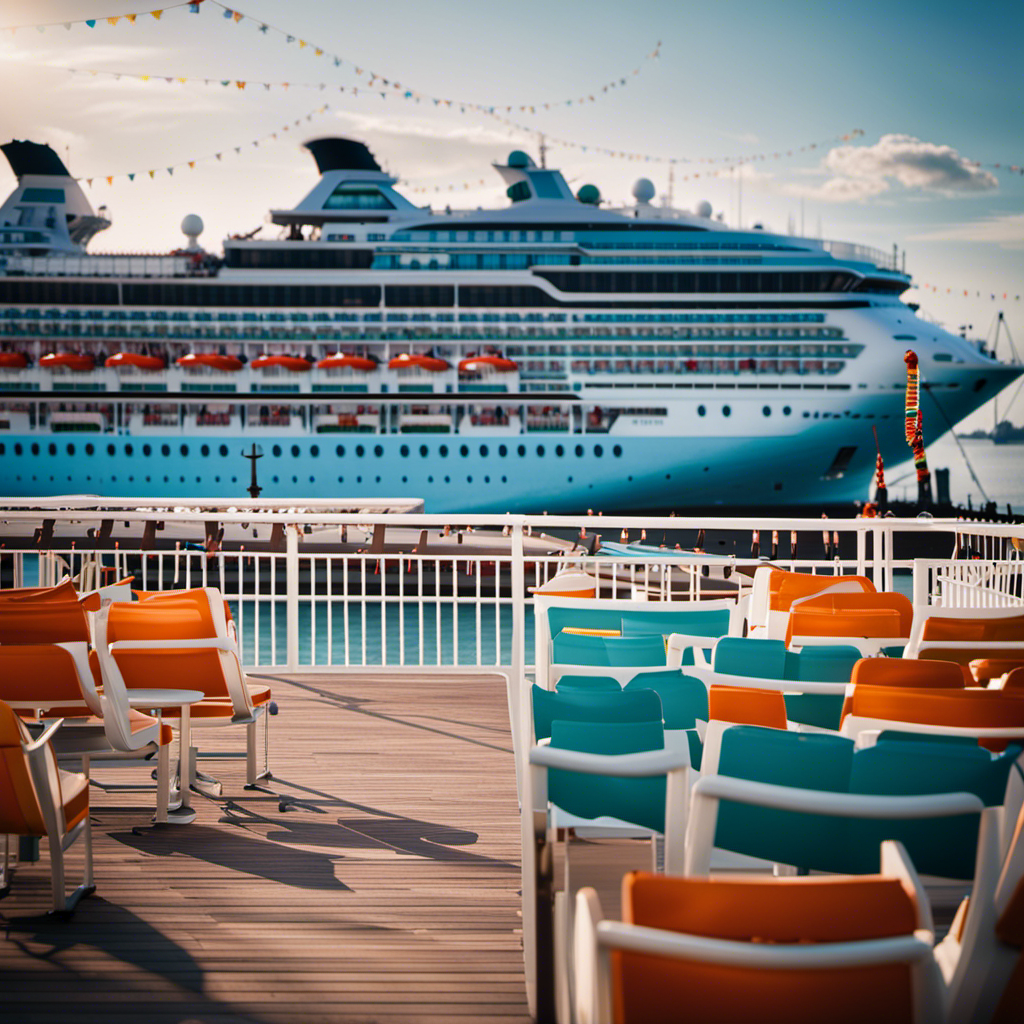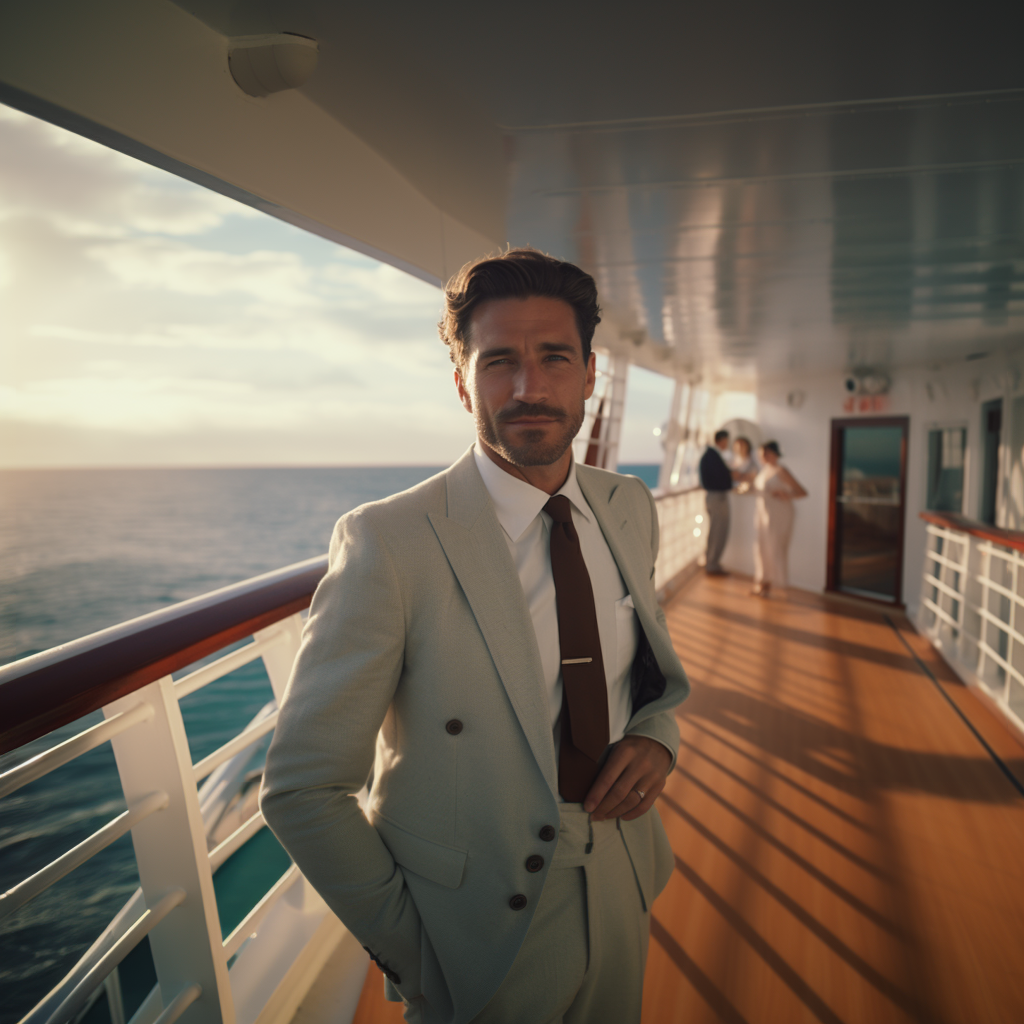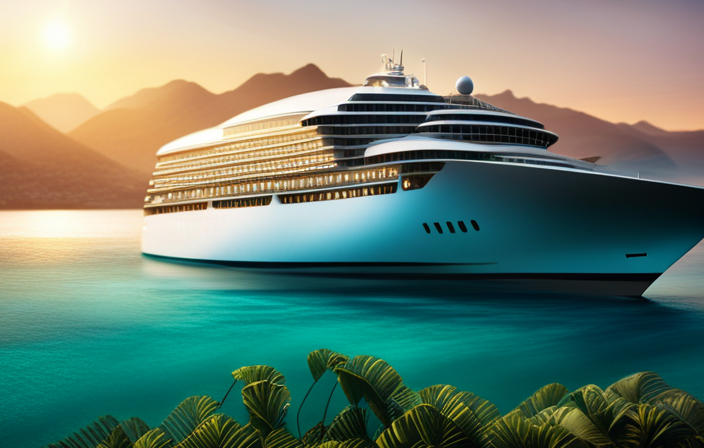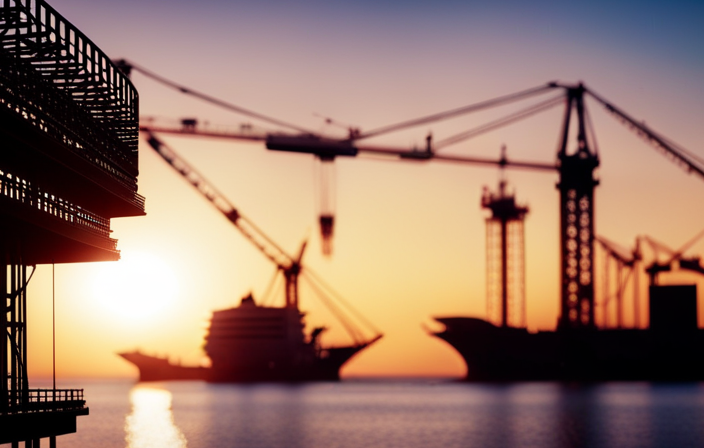Gazing from the shore at the boundless ocean, I am struck by admiration for the impressive structures that navigate its waters. Cruise ships, those grand floating cities bursting with luxury and adventure, serve as a testament to human innovation and imaginative prowess.
In this article, we will delve into the intricate dimensions and measurements of these behemoths, exploring their passenger capacity, gross tonnage, and onboard amenities. Prepare to be amazed as we compare these maritime marvels to iconic landmarks from around the world.
Key Takeaways
- Cruise ships can vary in size, with some measuring over 1,000 feet in length and as wide as a 10-lane highway.
- Ship design is crucial in achieving optimal passenger density and maximizing space utilization.
- Passenger capacity is determined by maximum occupancy limits and average passenger count, with an average count of around 3,000 people.
- Gross tonnage refers to the total internal volume of a ship and impacts ship size, stability, and weight distribution.
Dimensions and Measurements
Cruise ships vary in size, with some measuring over 1,000 feet in length. The dimensions and measurements of these floating behemoths are carefully designed to accommodate a large number of passengers while ensuring optimal passenger density. Ship design plays a crucial role in achieving this delicate balance.
From bow to stern, every inch of the ship is meticulously planned to maximize space utilization and create a comfortable environment for the guests. The layout includes spacious cabins, multiple decks, and various amenities such as restaurants, lounges, and entertainment venues. By strategically placing these features throughout the vessel, cruise ship designers ensure that the passenger density is distributed evenly, avoiding overcrowding in any particular area.
Moving forward, let’s delve into the next aspect of a cruise ship’s size: its passenger capacity.
Passenger Capacity
When it comes to passenger capacity on a cruise ship, there are two key factors to consider: maximum occupancy limits and average passenger count.
The maximum occupancy limits refer to the absolute maximum number of passengers that a ship can legally accommodate. This is determined by various safety regulations, including the availability of life-saving equipment and evacuation procedures.
On the other hand, the average passenger count reflects the typical number of passengers on a cruise ship during a voyage. It takes into account factors such as the ship’s amenities, popularity, and the time of year.
These two factors are important to consider when planning a cruise. The maximum occupancy limits ensure that the ship can safely accommodate all passengers in case of an emergency. The average passenger count gives an idea of the ship’s overall atmosphere and level of crowding during a voyage.
Maximum Occupancy Limits
To find out the maximum occupancy limits on a cruise ship, you can easily check the ship’s official website. The maximum occupancy rates are determined by safety regulations set by international maritime organizations. These regulations take into account factors such as the ship’s size, layout, and emergency evacuation capabilities. The maximum occupancy limits are established to ensure the safety and well-being of all passengers on board. Cruise ships are required to have sufficient lifeboats, life rafts, and other safety equipment to accommodate the maximum number of passengers allowed. It is important for cruise ship operators to adhere to these regulations to prevent overcrowding and maintain a safe environment for everyone on board.
When considering the maximum occupancy limits, it is also important to note the average passenger count on a cruise ship.
Average Passenger Count
If you’re curious, you’ll be pleased to know that the average passenger count on a cruise ship is around 3,000 people.
When it comes to passenger demographics, cruise ships cater to a wide range of individuals, from families with children to retirees looking for a relaxing getaway.
The average cruise duration varies depending on the itinerary, but it typically ranges from 7 to 14 days. This allows passengers to fully immerse themselves in the onboard amenities and explore multiple destinations during their voyage.
As we delve into the next section about ‘gross tonnage’, it is important to note that the number of passengers on a cruise ship plays a significant role in determining its overall size and capacity.
Gross Tonnage
When it comes to understanding the size and capacity of cruise ships, one important factor to consider is gross tonnage. Gross tonnage refers to the total internal volume of a ship, including all enclosed spaces. This measurement plays a significant role in determining the overall size and carrying capacity of a vessel, as well as its impact on various aspects of ship design and functionality.
Tonnage Measurement Explained
Understanding how tonnage is measured can give you a better idea of the size of a cruise ship. In order to calculate a ship’s tonnage, the weight distribution throughout the vessel is taken into account. This measurement is known as the gross tonnage (GT) and is a reflection of the total internal volume of the ship.
To accurately determine the tonnage, various factors such as the volume of enclosed spaces, the height of the ship’s superstructure, and the number of passengers and crew onboard are considered. It’s important to note that tonnage doesn’t directly correlate with the physical size of the ship, as weight distribution plays a significant role.
As we delve into the impact of tonnage on ship size, we will uncover the relationship between these two aspects without skipping a beat.
Impact on Ship Size
Weight distribution throughout a vessel has a significant impact on its size. When designing a cruise ship, careful consideration must be given to the distribution of weight in order to maintain stability and ensure safe operation. The weight of various components, such as engines, fuel tanks, and passenger areas, must be distributed evenly to prevent the ship from listing or capsizing. This impact on ship design is a crucial aspect of the construction process.
Engineers and naval architects work together to determine the optimal weight distribution for a ship, taking into account factors such as the ship’s intended use, size, and passenger capacity. By carefully considering weight distribution, cruise ship designers can create vessels that are not only safe and stable but also efficient and comfortable for passengers.
Now, let’s compare different cruise ships to understand their unique features and offerings.
Comparing Different Cruise Ships
To get a better idea of what each cruise ship offers, take a look at their unique features and offerings.
Cruise ship amenities play a crucial role in enhancing the passenger experience. From luxurious accommodations and gourmet dining options to world-class entertainment and recreational facilities, these amenities are designed to cater to the diverse needs and preferences of passengers.
State-of-the-art spas, fitness centers, swimming pools, and sports facilities provide opportunities for relaxation and active pursuits. Onboard theaters, casinos, and nightclubs offer a vibrant nightlife experience. Additionally, cruise ships often feature shopping malls, art galleries, libraries, and even educational programs. These amenities are carefully curated to provide a memorable and fulfilling vacation experience for passengers.
Transitioning into the subsequent section about ‘length and width,’ it is important to consider the physical dimensions of cruise ships.
Length and Width
Did you know that a cruise ship can be as long as three football fields and as wide as a 10-lane highway? Ship construction and cruise ship design play a crucial role in achieving such impressive dimensions.
When it comes to ship construction, cruise ships are built using advanced engineering techniques and materials to ensure stability and safety. The design of a cruise ship involves careful planning and consideration of various factors, such as passenger capacity, amenities, and fuel efficiency. These factors influence the length and width of the ship.
Cruise ships are designed to maximize space utilization, with multiple decks providing accommodation, dining, entertainment, and recreational areas for passengers. Moving between these deck levels is seamless, thanks to carefully designed staircases and elevators.
With their immense size and thoughtful construction, cruise ships offer a world of possibilities for passengers to explore and enjoy.
Deck Levels
When exploring the deck levels, you’ll find a variety of amenities and recreational areas to enjoy on a cruise ship. These areas are carefully designed and constructed with deck safety measures in mind. Here are some features you can expect to find:
-
Swimming pools: Take a refreshing dip in one of the ship’s many pools, complete with deck construction that ensures stability and safety even in rough seas.
-
Sports facilities: Stay active on board with sports facilities such as basketball courts or jogging tracks. These areas are built with durable materials to withstand heavy use and provide a safe environment for passengers.
-
Outdoor lounges: Relax and soak up the sun in one of the ship’s outdoor lounges. These spaces are designed with comfortable seating and proper deck construction to ensure your safety while enjoying the fresh sea breeze.
As you explore the deck levels and experience these amenities, you’ll find that the next section of the ship, the staterooms and suites, offers a comfortable and luxurious retreat.
Staterooms and Suites
The staterooms and suites on a cruise ship provide a comfortable and luxurious retreat for passengers. With a variety of stateroom options available, passengers can choose the size and layout that best suits their needs. From cozy interior staterooms to spacious balcony staterooms, there is something for everyone.
Suites, on the other hand, offer even more amenities and space, including separate living areas, private balconies, and enhanced services like priority check-in and butler service. Suite amenities may also include access to exclusive lounges, complimentary dining in specialty restaurants, and even personal concierge services. These accommodations provide passengers with a heightened level of comfort and luxury during their cruise experience.
As we transition to the next section about onboard amenities, passengers can also look forward to a wide range of entertainment, dining, and recreational options available onboard.
Onboard Amenities
In addition to the spacious staterooms and suites, cruise ships also offer a wide range of onboard amenities to enhance the passengers’ experience. One of the most popular amenities is the pool facilities. Most cruise ships have multiple pools, including adult-only pools, family-friendly pools, and even water parks with thrilling slides and splash zones. These pool areas are designed to provide relaxation and entertainment for passengers of all ages.
Another important aspect of onboard amenities is the dining options. Cruise ships are known for their diverse and high-quality food offerings. From elegant dining rooms serving gourmet meals to casual buffet-style restaurants, there is something to satisfy every palate. Many ships also feature specialty restaurants that offer cuisines from around the world, providing passengers with unique dining experiences.
With these pool facilities and dining options, cruise ship passengers can enjoy a wide range of activities and indulge in delicious meals throughout their voyage.
As we move on to the next section, we will compare the size of cruise ships to famous landmarks, giving you a better understanding of just how big these vessels truly are.
Comparison to Landmarks
Imagine standing next to famous landmarks and realizing just how small you are compared to these massive cruise ships.
When it comes to size comparisons with famous buildings, cruise ships are truly colossal. Take the Royal Caribbean’s Symphony of the Seas, for example. This ship is about 1,188 feet long and can carry up to 6,680 passengers. To put that into perspective, the ship is longer than the Eiffel Tower is tall and can hold more people than the Empire State Building can accommodate.
But it’s not just buildings that cruise ships dwarf. In relation to natural wonders, these ships are equally impressive. The Symphony of the Seas is longer than the height of Niagara Falls and can hold more passengers than the Grand Canyon can accommodate.
Standing next to a cruise ship truly emphasizes just how massive these vessels are in comparison to landmarks and natural wonders.
Frequently Asked Questions
What Is the Average Cost of a Cruise Ship Ticket?
The average cost of a cruise ship ticket varies depending on factors such as destination, duration, and cabin type. Discounts are often available for early booking, loyalty programs, and off-peak seasons.
Are There Any Age Restrictions for Passengers on Cruise Ships?
Age restrictions on cruise ships vary, but most ships have child-friendly amenities such as kids’ clubs and family-friendly entertainment. It’s important to check with the specific cruise line for their age policies.
How Many Crew Members Are Typically Onboard a Cruise Ship?
Typically, a cruise ship has a large number of crew members onboard. These crew members are responsible for various tasks and have their own accommodations on the ship.
Can I Bring My Own Food and Drinks Onboard a Cruise Ship?
Yes, you can bring your own food and drinks onboard a cruise ship. However, there are restrictions on bringing alcohol, so it’s best to check with the cruise line beforehand. Additionally, they accommodate dietary restrictions.
Are There Any Specific Dress Codes to Follow While on a Cruise Ship?
Cruise ship dress codes are essential for maintaining a sophisticated ambiance onboard. Guidelines and expectations ensure a stylish and comfortable experience. Fashion choices should reflect the elegant atmosphere while allowing for mobility and relaxation.
Conclusion
After delving into the world of cruise ships and exploring their vast dimensions, it is truly awe-inspiring to grasp the sheer size of these floating marvels. From the colossal length and width to the staggering number of deck levels, cruise ships are like floating cities, offering a multitude of amenities and accommodations.
The passenger capacity and gross tonnage only further emphasize their grandeur. As I stand here, contemplating the enormity of these vessels, it is impossible not to feel a sense of wonder and amazement at the engineering feats that make these magnificent ships possible.
Alfons is the visionary leader and driving force behind Voyager Info’s success. As the Editor in Chief, he brings a wealth of experience and an unwavering passion for travel to the helm of our cruise-centric platform.
With a lifelong fascination for exploring new horizons, Alfons discovered his love for the ocean and cruising at a young age. From sailing across pristine Caribbean waters to embarking on daring expeditions to far-flung destinations, he has amassed a treasure trove of first-hand experiences in the world of cruising.











